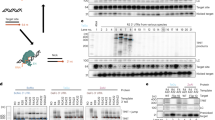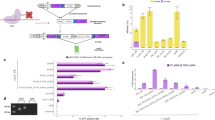Abstract
We describe novel transposon piggyBac vectors engineered to deliver transgenes as efficiently as currently available piggyBac systems, but with significantly less helper DNA co-delivered into the host genome. To generate these plasmids, we identified a previously unreported aspect of transposon biology, that the full-length terminal domains required for successful plasmid-to-chromatin transgene delivery can be removed from the transgene delivery cassette to other parts of the plasmid without significantly impairing transposition efficiency. This is achieved by including in the same plasmid, an additional helper piggyBac sequence that contains both long terminal domains, but is modified to prevent its transposition into the host genome. This design decreases the size of the required terminal domains within the delivered gene cassette of the piggyBac vector from about 1500 to just 98 base pairs. By removing these sequences from the delivered gene cassette, they are no longer incorporated into the host genome which may reduce the risk of target cell transformation.
This is a preview of subscription content, access via your institution
Access options
Subscribe to this journal
Receive 12 print issues and online access
$259.00 per year
only $21.58 per issue
Buy this article
- Purchase on Springer Link
- Instant access to full article PDF
Prices may be subject to local taxes which are calculated during checkout





Similar content being viewed by others
References
Meir YJ, Wu SC . Transposon-based vector systems for gene therapy clinical trials: challenges and considerations. Chang Gung Med J 2011; 34: 565–579.
Li SD, Huang L . Non-viral is superior to viral gene delivery. J Control Release 2007; 123: 181–183.
Kawakami S, Higuchi Y, Hashida M . Nonviral approaches for targeted delivery of plasmid DNA and oligonucleotide. J Pharm Sci 2008; 97: 726–745.
Nakanishi H, Higuchi Y, Kawakami S, Yamashita F, Hashida M . piggyBac transposon-mediated long-term gene expression in mice. Mol Ther 2010; 18: 707–714.
Li MA, Turner DJ, Ning Z, Yusa K, Liang Q, Eckert S et al. Mobilization of giant piggyBac transposons in the mouse genome. Nucleic Acids Res 2011; 39: e148.
Wilson MH, Coates CJ, George AL Jr. . PiggyBac transposon-mediated gene transfer in human cells. Mol Ther 2007; 15: 139–145.
Wu SC, Meir YJ, Coates CJ, Handler AM, Pelczar P, Moisyadi S et al. piggyBac is a flexible and highly active transposon as compared to sleeping beauty, Tol2, and Mos1 in mammalian cells. Proc Natl Acad Sci USA 2006; 103: 15008–15013.
Cary LC, Goebel M, Corsaro BG, Wang HG, Rosen E, Fraser MJ . Transposon mutagenesis of baculoviruses: analysis of Trichoplusia ni transposon IFP2 insertions within the FP-locus of nuclear polyhedrosis viruses. Virology 1989; 172: 156–169.
Zhuang L, Wei H, Lu C, Zhong B . The relationship between internal domain sequences of piggyBac and its transposition efficiency in BmN cells and Bombyx mori. Acta Biochim Biophys Sin (Shanghai) 2010; 42: 426–431.
Li X, Heinrich JC, Scott MJ . piggyBac-mediated transposition in Drosophila melanogaster: an evaluation of the use of constitutive promoters to control transposase gene expression. Insect Mol Biol 2001; 10: 447–455.
Fraser MJ, Ciszczon T, Elick T, Bauser C . Precise excision of TTAA-specific lepidopteran transposons piggyBac (IFP2) and tagalong (TFP3) from the baculovirus genome in cell lines from two species of Lepidoptera. Insect Mol Biol 1996; 5: 141–151.
Handler AM, McCombs SD, Fraser MJ, Saul SH . The lepidopteran transposon vector, piggyBac, mediates germ-line transformation in the Mediterranean fruit fly. Proc Natl Acad Sci USA 1998; 95: 7520–7525.
Li X, Harrell RA, Handler AM, Beam T, Hennessy K, Fraser MJ Jr. . piggyBac internal sequences are necessary for efficient transformation of target genomes. Insect Mol Biol 2005; 14: 17–30.
Elick TA, Bauser CA, Fraser MJ . Excision of the piggyBac transposable element in vitro is a precise event that is enhanced by the expression of its encoded transposase. Genetica 1996; 98: 33–41.
Elick TA, Lobo N, Fraser MJ Jr. . Analysis of the cis-acting DNA elements required for piggyBac transposable element excision. Mol Gen Genet 1997; 255: 605–610.
Li X, Lobo N, Bauser CA, Fraser MJ Jr . The minimum internal and external sequence requirements for transposition of the eukaryotic transformation vector piggyBac. Mol Genet Genomics 2001; 266: 190–198.
Cadinanos J, Bradley A . Generation of an inducible and optimized piggyBac transposon system. Nucleic Acids Res 2007; 35: e87.
Meir YJ, Weirauch MT, Yang HS, Chung PC, Yu RK, Wu SC . Genome-wide target profiling of piggyBac and Tol2 in HEK 293: pros and cons for gene discovery and gene therapy. BMC Biotechnol 2011; 11: 28.
Shi X, Harrison RL, Hollister JR, Mohammed A, Fraser MJ Jr, Jarvis DL . Construction and characterization of new piggyBac vectors for constitutive or inducible expression of heterologous gene pairs and the identification of a previously unrecognized activator sequence in piggyBac. BMC Biotechnol 2007; 7: 5.
Kahlig KM, Saridey SK, Kaja A, Daniels MA, George AL Jr, Wilson MH . Multiplexed transposon-mediated stable gene transfer in human cells. Proc Natl Acad Sci USA 2010; 107: 1343–1348.
Yusa K, Rad R, Takeda J, Bradley A . Generation of transgene-free induced pluripotent mouse stem cells by the piggyBac transposon. Nat Methods 2009; 6: 363–369.
King J, Hamil T, Creighton J, Wu S, Bhat P, McDonald F et al. Structural and functional characteristics of lung macro- and microvascular endothelial cell phenotypes. Microvasc Res 2004; 67: 139–151.
Acknowledgements
We thank Dr Alfred M Handler (U.S. Department of Agriculture) for providing the p3E1.2 plasmid. This work was supported in part by Grant-in-Aid awards from the Greater SouthEast Affiliate of the American Heart Association to VS (12GRNT12070291) and BF (09GRNT2260914).
Author information
Authors and Affiliations
Corresponding author
Ethics declarations
Competing interests
The authors declare no conflict of interest.
Rights and permissions
About this article
Cite this article
Solodushko, V., Bitko, V. & Fouty, B. Minimal piggyBac vectors for chromatin integration. Gene Ther 21, 1–9 (2014). https://doi.org/10.1038/gt.2013.52
Received:
Revised:
Accepted:
Published:
Issue Date:
DOI: https://doi.org/10.1038/gt.2013.52
Keywords
This article is cited by
-
The Functionality of Minimal PiggyBac Transposons in Mammalian Cells
Molecular Therapy - Nucleic Acids (2016)
-
Simple viral/minimal piggyBac hybrid vectors for stable production of self-inactivating gamma-retroviruses
BMC Research Notes (2015)



